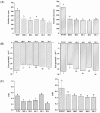Physicochemical Properties, Antioxidant Capacity and Bioavailability of Whey Protein Concentrate-Based Coenzyme Q10 Nanoparticles
- PMID: 39765863
- PMCID: PMC11727553
- DOI: 10.3390/antiox13121535
Physicochemical Properties, Antioxidant Capacity and Bioavailability of Whey Protein Concentrate-Based Coenzyme Q10 Nanoparticles
Abstract
Coenzyme Q10 (CoQ10) is a powerful antioxidant. However, the poor water solubility and low bioavailability still remain challenges for its application. An embedded delivery system of CoQ10 based on whey protein concentrate (WPC) and polymerized whey protein concentrate (PWPC) was prepared, and the physicochemical properties, antioxidant capacity and bioavailability were characterized in this study. Both groups of nanoparticles showed a particle size distribution from 241 to 331 nm in the protein-to-CoQ10 mass ratio range of 100:1 to 20:1. In addition, the minimum polydispersity index value was observed at the mass ratio of 20:1. Differential scanning calorimetry and Fourier transform infrared spectra analysis revealed that the CoQ10 was successfully dispersed in the WPC and PWPC particles through hydrophobic interaction in both groups in addition to the hydrogen bond present in the WPC group. All nanoparticles exhibited irregular spherical or aggregate structure in the transmission electron microscopy diagram. The PWPC-based nanoparticles showed a slightly higher antioxidant capacity than that of the WPC, and both values were significantly higher than that of its corresponding physical mixture and free CoQ10 (p < 0.05). The results of the simulated gastrointestinal digestion experiments denoted that these two nanoparticles could protect CoQ10 from gastric digestion and then deliver it to the intestine. Compared with its free state, the bioavailability of CoQ10 embedded in WPC and PWPC increased by nearly 7.58 times and 7.48 times, respectively. The data indicated that WPC and PWPC could be effective delivery carriers to enhance the bioavailability of active substances like CoQ10.
Keywords: antioxidant capacity; bioavailability; coenzyme CoQ10; physicochemical properties; whey protein.
Conflict of interest statement
The authors declare no conflicts of interest.
Figures









Similar articles
-
Polymerized Whey Protein Concentrate-Based Glutathione Delivery System: Physicochemical Characterization, Bioavailability and Sub-Chronic Toxicity Evaluation.Molecules. 2021 Mar 24;26(7):1824. doi: 10.3390/molecules26071824. Molecules. 2021. PMID: 33805036 Free PMC article.
-
Enhanced Stability and Oral Bioavailability of Folic Acid-Dextran-Coenzyme Q10 Nanopreparation by High-Pressure Homogenization.J Agric Food Chem. 2018 Sep 19;66(37):9690-9696. doi: 10.1021/acs.jafc.8b02660. Epub 2018 Sep 6. J Agric Food Chem. 2018. PMID: 30141926
-
Ultrasound-Induced Changes in Physicochemical, Microstructural, and Antioxidative Properties of Whey-Protein-Concentrate-Encapsulated 3,3'-Diindolylmethane Nanoparticles.Antioxidants (Basel). 2025 Feb 26;14(3):273. doi: 10.3390/antiox14030273. Antioxidants (Basel). 2025. PMID: 40227197 Free PMC article.
-
Bioavailability enhancement of coenzyme Q10: An update of novel approaches.Arch Pharm (Weinheim). 2024 Aug;357(8):e2300676. doi: 10.1002/ardp.202300676. Epub 2024 Apr 29. Arch Pharm (Weinheim). 2024. PMID: 38683827 Review.
-
Bioavailability enhancement of coenzyme Q10: an extensive review of patents.Recent Pat Drug Deliv Formul. 2010 Nov;4(3):245-55. doi: 10.2174/187221110793237565. Recent Pat Drug Deliv Formul. 2010. PMID: 20863275 Review.
Cited by
-
Nanomaterials reshape the pulmonary mechanical microenvironment: novel therapeutic strategies for respiratory diseases.Front Bioeng Biotechnol. 2025 May 2;13:1597387. doi: 10.3389/fbioe.2025.1597387. eCollection 2025. Front Bioeng Biotechnol. 2025. PMID: 40386463 Free PMC article. Review.
References
-
- Yubero-Serrano E.M., Delgado-Casado N., Delgado-Lista J., Perez-Martinez P., Tasset-Cuevas I., Santos-Gonzalez M., Caballero J., Garcia-Rios A., Marin C., Gutierrez-Mariscal F.M., et al. Postprandial antioxidant effect of the Mediterranean diet supplemented with coenzyme Q10 in elderly men and women. Age. 2011;33:579–590. doi: 10.1007/s11357-010-9199-8. - DOI - PMC - PubMed
-
- González-Guardia L., Yubero-Serrano E.M., Delgado-Lista J., Perez-Martinez P., Garcia-Rios A., Marin C., Camargo A., Delgado-Casado N., Roche H.M., Perez-Jimenez F., et al. Effects of the Mediterranean Diet Supplemented with coenzyme Q10 on metabolomic profiles in elderly men and women. J. Gerontol. A Biol. 2015;70:78–84. doi: 10.1093/gerona/glu098. - DOI - PubMed
-
- Dumont M., Kipiani K., Yu F.M., Wille E., Katz M., Calingasan N.Y., Gouras G.K., Lin M.T., Beal M.F. Coenzyme Q10 decreases amyloid pathology and improves behavior in a transgenic mouse model of Alzheimer’s disease. J. Alzheimers Dis. 2011;27:211–223. doi: 10.3233/JAD-2011-110209. - DOI - PMC - PubMed
-
- Bakhshayeshkaram M., Lankarani K.B., Mirhosseini N., Tabrizi R., Akbari M., Dabbaghmanesh M.H., Asemi Z. The effects of Coenzyme Q10 supplementation on metabolic profiles of patients with chronic kidney disease: A systematic review and meta-analysis of randomized controlled trials. Curr. Pharm. Des. 2018;24:3710–3723. doi: 10.2174/1381612824666181112112857. - DOI - PubMed
LinkOut - more resources
Full Text Sources

